Drought Resilience in Oil Palm Cultivars: A Multidimensional Analysis of Diagnostic Variables
Abstract
1. Introduction
2. Results
2.1. Growth Parameters
2.2. Physiological Parameters
2.3. Biochemical Parameters
2.4. Principal Component Analysis
3. Discussion
4. Materials and Methods
4.1. Location
4.2. Plant Material
4.3. Drought Treatment
4.4. Growth Parameters
4.5. Physiological Parameters
4.6. Biochemical Parameters
4.7. Statistical Analysis
5. Conclusions
Author Contributions
Funding
Data Availability Statement
Acknowledgments
Conflicts of Interest
References
- Masani, M.Y.A.; Izawati, A.M.D.; Rasid, O.A.; Parveez, G.K.A. Biotechnology of oil palm: Current status of oil palm genetic transformation. Biocatal. Agric. Biotechnol. 2018, 15, 335–347. [Google Scholar] [CrossRef]
- Sibhatu, K.T. Oil palm boom: Its socioeconomic use and abuse. Front. Sustain. Food Syst. 2023, 7, 1083022. [Google Scholar] [CrossRef]
- Zulkifli, Y.; Norziha, A.; Naqiuddin, M.; Fadila, A.; Nor, A.; Suzana, M.; Samsul, K.; Ong-Abdullah, M.; Singh, R.; Ghulam, K. Designing the oil palm of the future. J. Oil Palm Res. 2017, 29, 440–455. [Google Scholar]
- Cros, D.; Tchounke, B.; Nkague-Nkamba, L. Training genomic selection models across several breeding cycles increases genetic gain in oil palm in silico study. Mol. Breed. 2018, 38, 1–12. [Google Scholar] [CrossRef]
- Feller, U. Drought stress and carbon assimilation in a warming climate: Reversible and irreversible impacts. J. Plant Physiol. 2016, 203, 84–94. [Google Scholar] [CrossRef]
- Yue, G.H.; Ye, B.Q.; Lee, M. Molecular approaches for improving oil palm for oil. Mol. Breed. 2021, 41, 1–17. [Google Scholar] [CrossRef]
- Lau, B.Y.C.; Othman, A.; Ramli, U.S. Application of Proteomics Technologies in Oil Palm Research. Protein. J. 2018, 37, 473–499. [Google Scholar] [CrossRef]
- Euler, M.; Hoffmann, M.P.; Fathoni, Z.; Schwarze, S. Exploring yield gaps in smallholder oil palm production systems in eastern Sumatra, Indonesia. Agric. Syst. 2016, 146, 111–119. [Google Scholar] [CrossRef]
- Fedepalma. The oil palm agroindustry in Colombia and the world 2017–2021. In Statistical Yearbook 2022; Fedepalma: Bogota, Columbia, 2022; p. 254. [Google Scholar]
- Meja, J. Consumo de agua por la palma de aceite y efectos del riego sobre la producción de racimos, una revisión de literatura. Rev. Palmas 2000, 21, 51–58. [Google Scholar]
- Tiemann, T.; Donough, C.; Lim, Y.; Härdter, R.; Norton, R.; Tao, H.; Jaramillo, R.; Satyanarayana, T.; Zingore, S.; Oberthür, T. Feeding the Palm: A Review of Oil Palm Nutrition. In Advances in Agronomy; Elsevier: Amsterdam, The Netherlands, 2018; Volume 152, pp. 149–243. [Google Scholar]
- Silva, P.A.; Cosme, V.S.; Rodrigues, K.C.B.; Detmann, K.S.C.; Leo, F.M.; Cunha, R.L.A. Drought tolerance in two oil palm hybrids as related to adjustments in carbon metabolism and vegetative growth. Acta Physiol. Plant 2017, 39, 58. [Google Scholar] [CrossRef]
- Bayona-Rodriguez, C.J.; Romero, H.M. Physiological and agronomic behavior of commercial cultivars of oil palm (‘Elaeis guineensis’) and OxG hybrids (‘Elaeis oleifera’ × ‘Elaeis guineensis’) at rainy and dry seasons. Aust. J. Crop Sci. 2019, 13, 424–432. [Google Scholar] [CrossRef]
- Bayona-Rodríguez, C.J.; Ochoa-Cadavid, I.; Romero, H.M. Impacts of the dry season on the gas exchange of oil palm (Elaeis guineensis) and interspecific hybrid (Elaeis oleifera × Elaeis guineensis) progenies under field conditions in eastern Colombia. Agron. Colombiana 2016, 34, 329–335. [Google Scholar] [CrossRef]
- Rivera, Y.; Moreno, L.; Bayona, C.J.; Romero, H.M. Physiological response of oil palm interspecific hybrids (Elaeis oleifera H. B. K. Cortes versus Elaeis guineensis Jacq.) to water deficit. Braz. J. Plant Physiol. 2012, 24, 273–280. [Google Scholar]
- Azzeme, A.M.; Abdullah, S.N.A.; Aziz, M.A.; Wahab, P.E.M. Oil palm leaves and roots differ in physiological response, antioxidant enzyme activities and expression of stress-responsive genes upon exposure to drought stress. Acta Physiol. Plant. 2016, 38, 52. [Google Scholar] [CrossRef]
- Tittinutchanon, P.; Nakharin, C.; Clendon, J.; Corley, R. A review of 15 years of oil palm irrigation research in Southern Thailand. Planter 2008, 84, 537–546. [Google Scholar]
- Duangpan, S.; Buapet, P.; Sujitto, S.; Eksomtramage, T. Early assessment of drought tolerance in oil palm D× P progenies using growth and physiological characters in seedling stage. Plant Genet. Resour. 2018, 16, 544–554. [Google Scholar] [CrossRef]
- Jazayeri, S.M.a. Physiological effects of water deficit on two oil palm (Elaeis guineensis Jacq.) genotypes. Agron. Colomb. 2015, 33, 164–173. [Google Scholar] [CrossRef]
- Silva, P.A.; Oliveira, I.V.; Rodrigues, K.C.B.; Cosme, V.S.; Bastos, A.J.R.; Detmann, K.S.C.; Cunha, R.L.; Festucci-Buselli, R.A.; DaMatta, F.M.; Pinheiro, H.A. Leaf gas exchange and multiple enzymatic and non-enzymatic antioxidant strategies related to drought tolerance in two oil palm hybrids. Trees Struct. Funct. 2016, 30, 203–214. [Google Scholar] [CrossRef]
- Suresh, K.; Nagamani, C.; Kantha, D.L.; Kumar, M.K. Changes in photosynthetic activity in five common hybrids of oil palm (Elaeis guineensis Jacq.) seedlings under water deficit. Photosynthetica 2012, 50, 549–556. [Google Scholar] [CrossRef]
- Wang, X.; Wu, Z.; Zhou, Q.; Wang, X.; Song, S.; Dong, S. Physiological response of soybean plants to water deficit. Front. Plant Sci. 2022, 12, 809692. [Google Scholar] [CrossRef]
- Corrêa, T.R.; Picoli, E.A.d.T.; Pereira, W.L.; Condé, S.A.; Resende, R.T.; de Resende, M.D.V.; da Costa, W.G.; Cruz, C.D.; Zauza, E.A.V. Very Early Biomarkers Screening for Water Deficit Tolerance in Commercial Eucalyptus Clones. Agronomy 2023, 13, 937. [Google Scholar] [CrossRef]
- Shahid, S.; Ali, Q.; Ali, S.; Al-Misned, F.A.; Maqbool, S. Water deficit stress tolerance potential of newly developed wheat genotypes for better yield based on agronomic traits and stress tolerance indices: Physio-biochemical responses, lipid peroxidation and antioxidative defense mechanism. Plants 2022, 11, 466. [Google Scholar] [CrossRef] [PubMed]
- Putra, E.; Purwanto, B.; Indradewa, D. Induction of biochemical resistance of oil palm seedlings to drought stress using boron and silicon applications. J. Biol. Sci. 2016, 16, 155–166. [Google Scholar] [CrossRef]
- Henson, I.; Chai, S. Analysis of oil palm productivity. II. Biomass, distribution, productivity and turnover of the root system. Elaeis 1997, 9, 78–92. [Google Scholar]
- Nodichao, L.; Chopart, J.-L.; Roupsard, O.; Vauclin, M.; Aké, S.; Jourdan, C. Genotypic variability of oil palm root system distribution in the field. Consequences for water uptake. Plant Soil 2011, 341, 505–520. [Google Scholar] [CrossRef]
- Eksteen, A.; Singels, A.; Ngxaliwe, S. Water relations of two contrasting sugarcane genotypes. Field Crops Res. 2014, 168, 86–100. [Google Scholar] [CrossRef]
- Langner, J.A.; Lago, I.; Reiniger, L.R.S.; Petry, M.T.; Streck, N.A.; Durigon, A.; Pohlmann, V.; Freitas, C.P.D.O.D.; Slim, T.; Silva, S.D.D. Water-deficit tolerance of landrace and improved corn genotypes. Pesqui. Agropecuária Bras. 2022, 56, e02627. [Google Scholar] [CrossRef]
- Aslam, S.; Hussain, S.B.; Baber, M.; Shaheen, S.; Aslam, S.; Waheed, R.; Seo, H.; Azhar, M.T. Estimation of Drought Tolerance Indices in Upland Cotton under Water Deficit Conditions. Agronomy 2023, 13, 984. [Google Scholar] [CrossRef]
- Banik, P.; Zeng, W.; Tai, H.; Bizimungu, B.; Tanino, K. Effects of drought acclimation on drought stress resistance in potato (Solanum tuberosum L.) genotypes. Environ. Exp. Bot. 2016, 126, 76–89. [Google Scholar] [CrossRef]
- Rivera-Mendes, Y.D.; Cuenca, J.C.; Romero, H.M. Physiological responses of oil palm (Elaeis guineensis Jacq.) seedlings under different water soil conditions. Agron. Colomb. 2016, 34, 163–171. [Google Scholar] [CrossRef]
- Li, Y.; Li, H.; Li, Y.; Zhang, S. Improving water-use efficiency by decreasing stomatal conductance and transpiration rate to maintain higher ear photosynthetic rate in drought-resistant wheat. Crop. J. 2017, 5, 231–239. [Google Scholar] [CrossRef]
- Maxwell, K.; Johnson, G.N. Chlorophyll fluorescence—A practical guide. J. Exp. Bot. 2000, 51, 659–668. [Google Scholar] [CrossRef]
- Baker, N.R.; Rosenqvist, E. Applications of chlorophyll fluorescence can improve crop production strategies: An examination of future possibilities. J. Exp. Bot. 2004, 55, 1607–1621. [Google Scholar] [CrossRef]
- Cha-um, S.; Yamada, N.; Takabe, T.; Kirdmanee, C. Physiological features and growth characters of oil palm (Elaeis guineensis jacq.) in response to reduced water-deficit and rewatering. Aust. J. Crop Sci. 2013, 7, 432–439. [Google Scholar]
- Ali, F.; Bano, A.; Fazal, A. Recent methods of drought stress tolerance in plants. Plant Growth Regul. 2017, 82, 363–375. [Google Scholar] [CrossRef]
- Rane, J.; Singh, A.K.; Tiwari, M.; Prasad, P.; Jagadish, S. Effective use of water in crop plants in dryland agriculture: Implications of reactive oxygen species and antioxidative system. Front. Plant Sci. 2022, 12, 778270. [Google Scholar] [CrossRef]
- Cao, H.-X.; Sun, C.-X.; Shao, H.-B.; Lei, X.-T. Effects of low temperature and drought on the physiological and growth changes in oil palm seedlings. Afr. J. Biotechnol. 2011, 10, 2630–2637. [Google Scholar] [CrossRef]
- Iqbal, S.; Wang, X.; Mubeen, I.; Kamran, M.; Kanwal, I.; Díaz, G.A.; Abbas, A.; Parveen, A.; Atiq, M.N.; Alshaya, H. Phytohormones trigger drought tolerance in crop plants: Outlook and future perspectives. Front. Plant Sci. 2022, 12, 3378. [Google Scholar] [CrossRef]
- Zargar, S.M.; Gupta, N.; Nazir, M.; Mahajan, R.; Malik, F.A.; Sofi, N.R.; Shikari, A.B.; Salgotra, R.K. Impact of drought on photosynthesis: Molecular perspective. Plant Gene 2017, 11, 154–159. [Google Scholar] [CrossRef]
- Omidvar, V.; Abdullah, S.N.A.; Ho, C.L.; Mahmood, M.; Al-Shanfari, A.B. Isolation and characterization of two ABRE-binding proteins: EABF and EABF1 from the oil palm. Mol. Biol. Rep. 2012, 39, 8907–8918. [Google Scholar] [CrossRef] [PubMed]
- DuBois, M.; Gilles, K.A.; Hamilton, J.K.; Rebers, P.A.; Smith, F. Colorimetric method for determination of sugars and related substances. Anal. Chem. 1956, 28, 350–356. [Google Scholar] [CrossRef]
- Nelson, N. A photometric adaptation of the Somogyi method for the determination of glucose. J. Biol. Chem. 1944, 153, 375–380. [Google Scholar] [CrossRef]
- Somogyi, M. Determination somogyi. J. Biol. Chem. 1945, 160, 61–68. [Google Scholar] [CrossRef]
- Bates, L.S.; Waldren, R.P.; Teare, I.D. Short communication: Rapid determination of free proline for water-stress studies. Plant Soil 1973, 19, 205–207. [Google Scholar] [CrossRef]
- Baron, K.N.; Schroeder, D.F.; Stasolla, C. Transcriptional response of abscisic acid (ABA) metabolism and transport to cold and heat stress applied at the reproductive stage of development in Arabidopsis thaliana. Plant Sci. 2012, 188, 48–59. [Google Scholar] [CrossRef] [PubMed]
- Bergmeyer, H.U. Methods of Enzymatic Analysis, 2nd ed.; Academic Press: New York, NY, USA, 1974; Volume 2, p. 400. [Google Scholar]
- Kireyko, A.; Veselova, I.; Shekhovtsova, T. Mechanisms of peroxidase oxidation of o-dianisidine, 3,3′,5,5′-tetramethylbenzidine, and o-phenylenediamine in the presence of sodium dodecyl sulfate. Russ. J. Bioorganic Chem. 2006, 32, 71–77. [Google Scholar] [CrossRef]
- Nakano, Y.; Asada, K. Hydrogen peroxide is scavenged by ascorbate-specific peroxidase in spinach chloroplasts. Plant Cell Physiol. 1981, 22, 867–880. [Google Scholar]
- Yannarelli, G.G.; Fernández-Alvarez, A.J.; Santa-Cruz, D.M.; Tomaro, M.L. Glutathione reductase activity and isoforms in leaves and roots of wheat plants subjected to cadmium stress. Phytochemistry 2007, 68, 505–512. [Google Scholar] [CrossRef] [PubMed]
- Fridovich, I. Superoxide dismutases. Annu. Rev. Biochem. 1975, 44, 147–159. [Google Scholar] [CrossRef]
- Bradford, M. A Rapid and Sensitive Method for the Quantitation of Microgram Quantities of Protein Utilizing the Principle of Protein-Dye Binding. Anal. Biochem. 1976, 72, 248–254. [Google Scholar] [CrossRef]


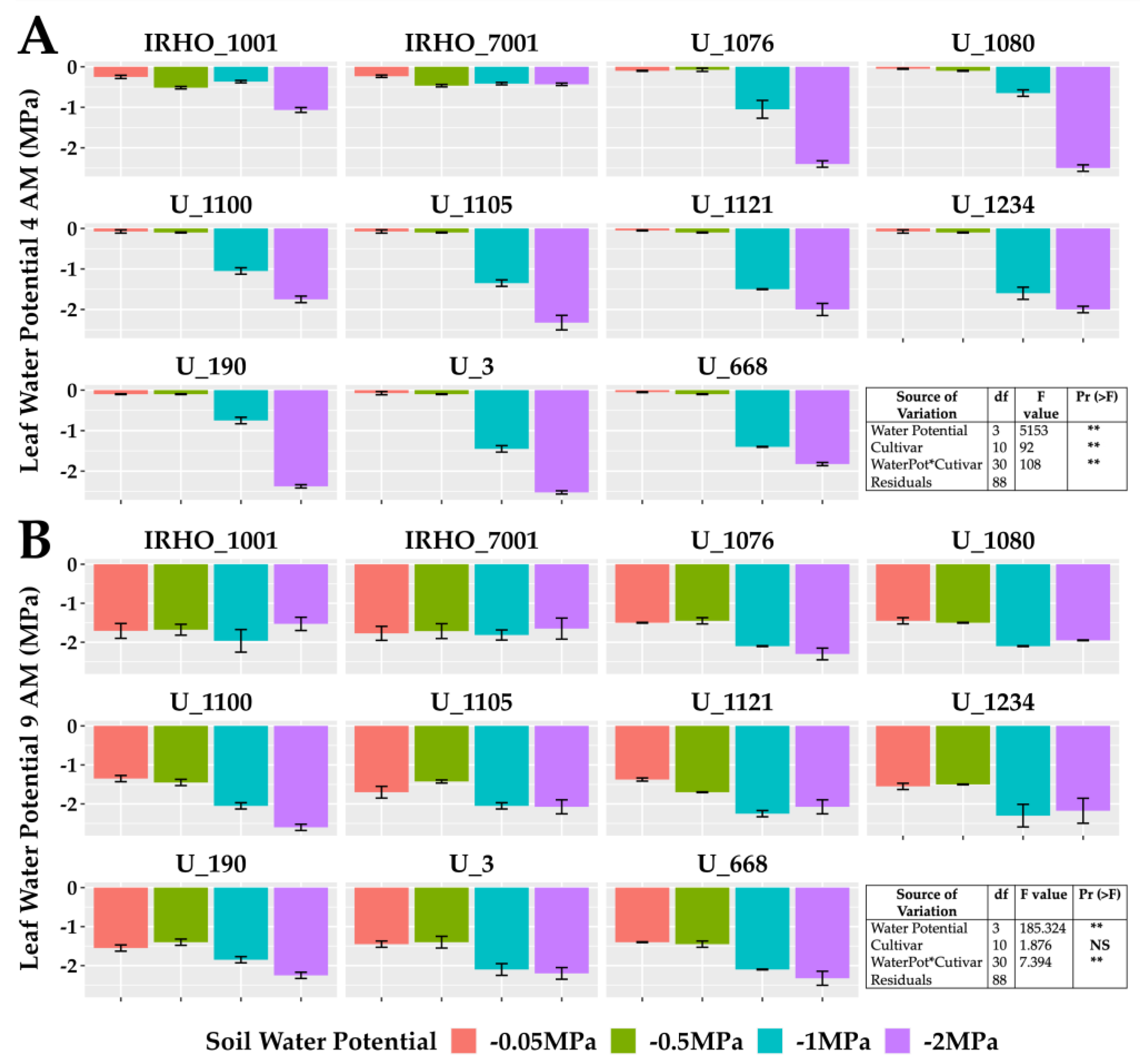
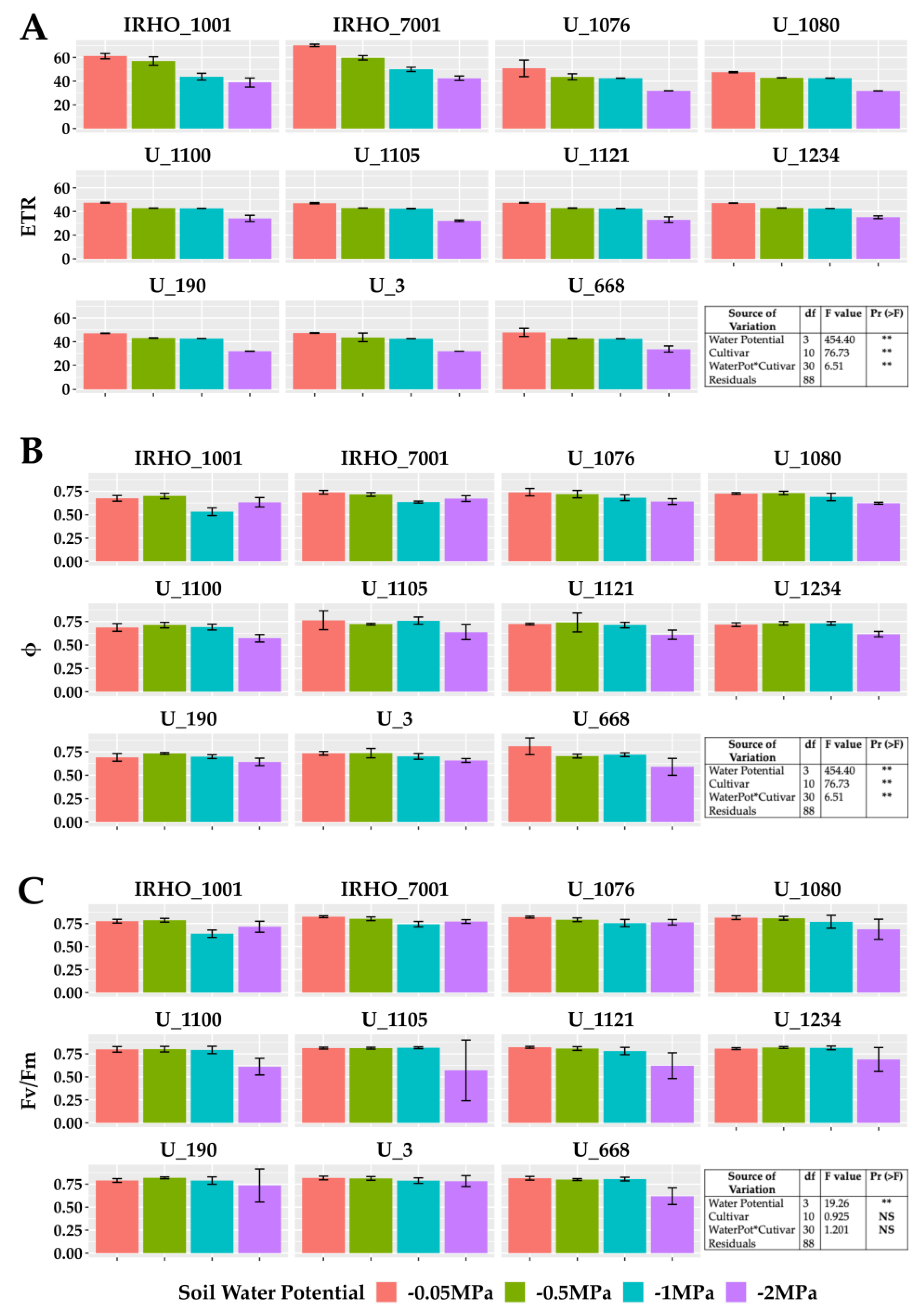
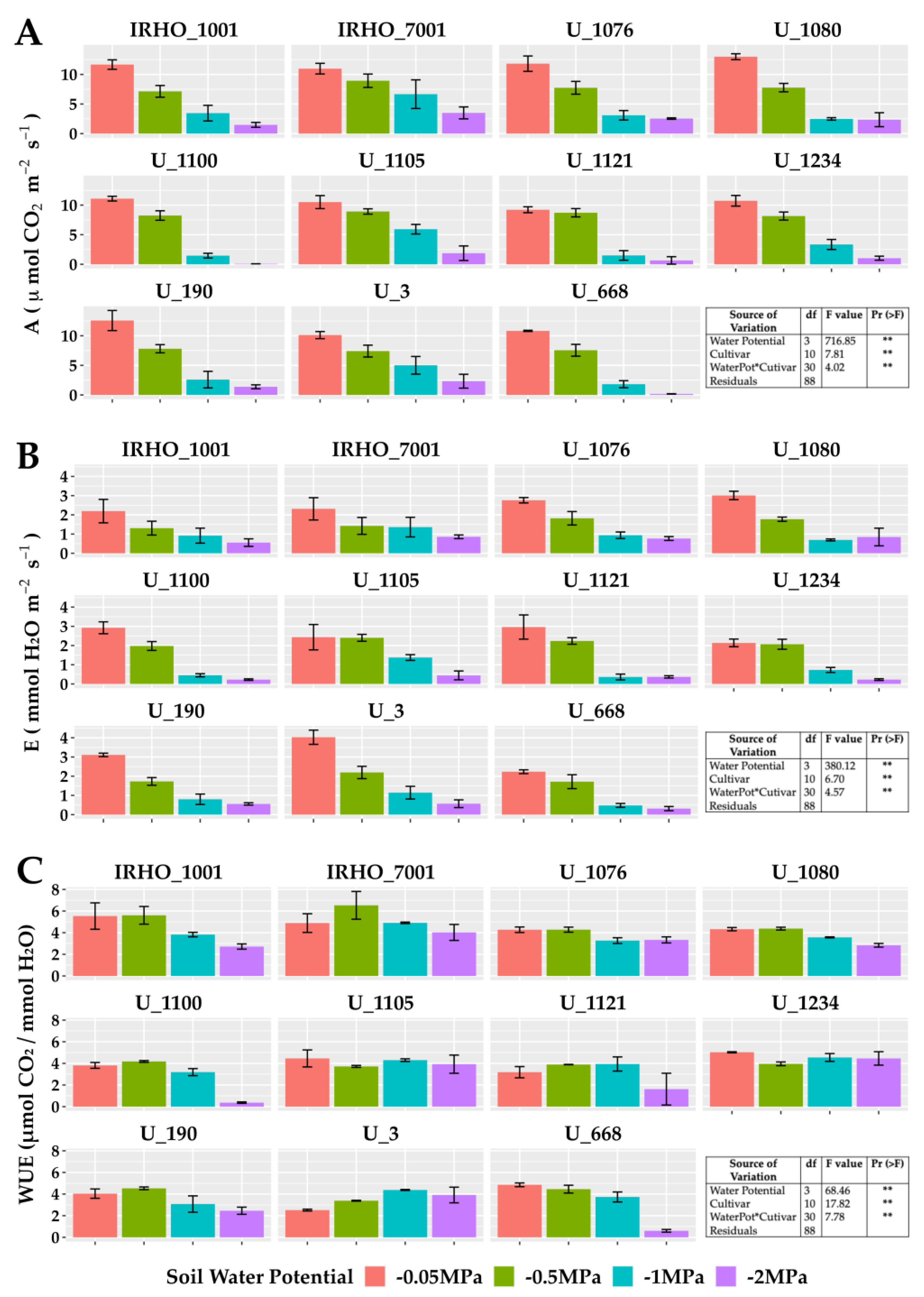
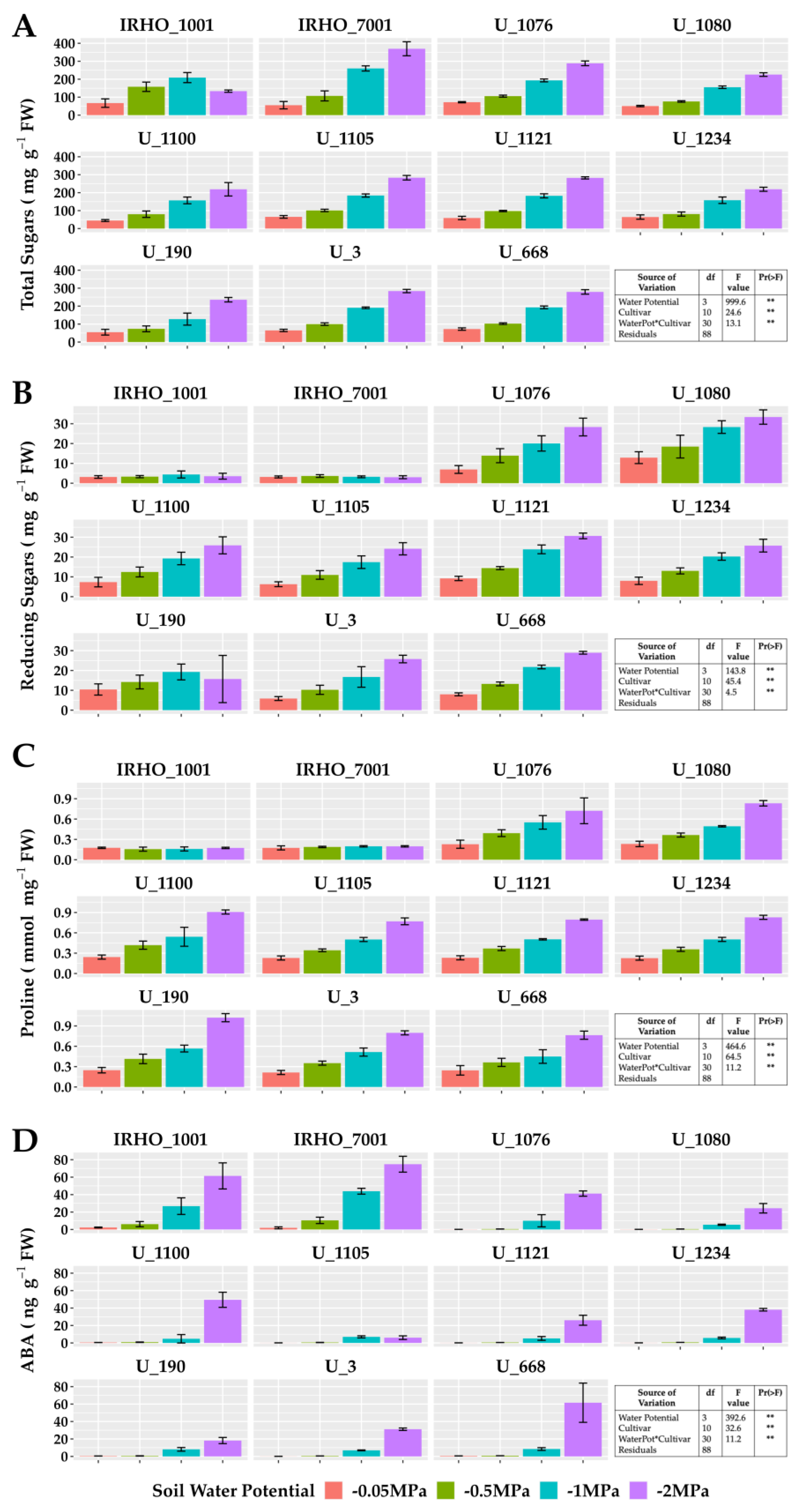
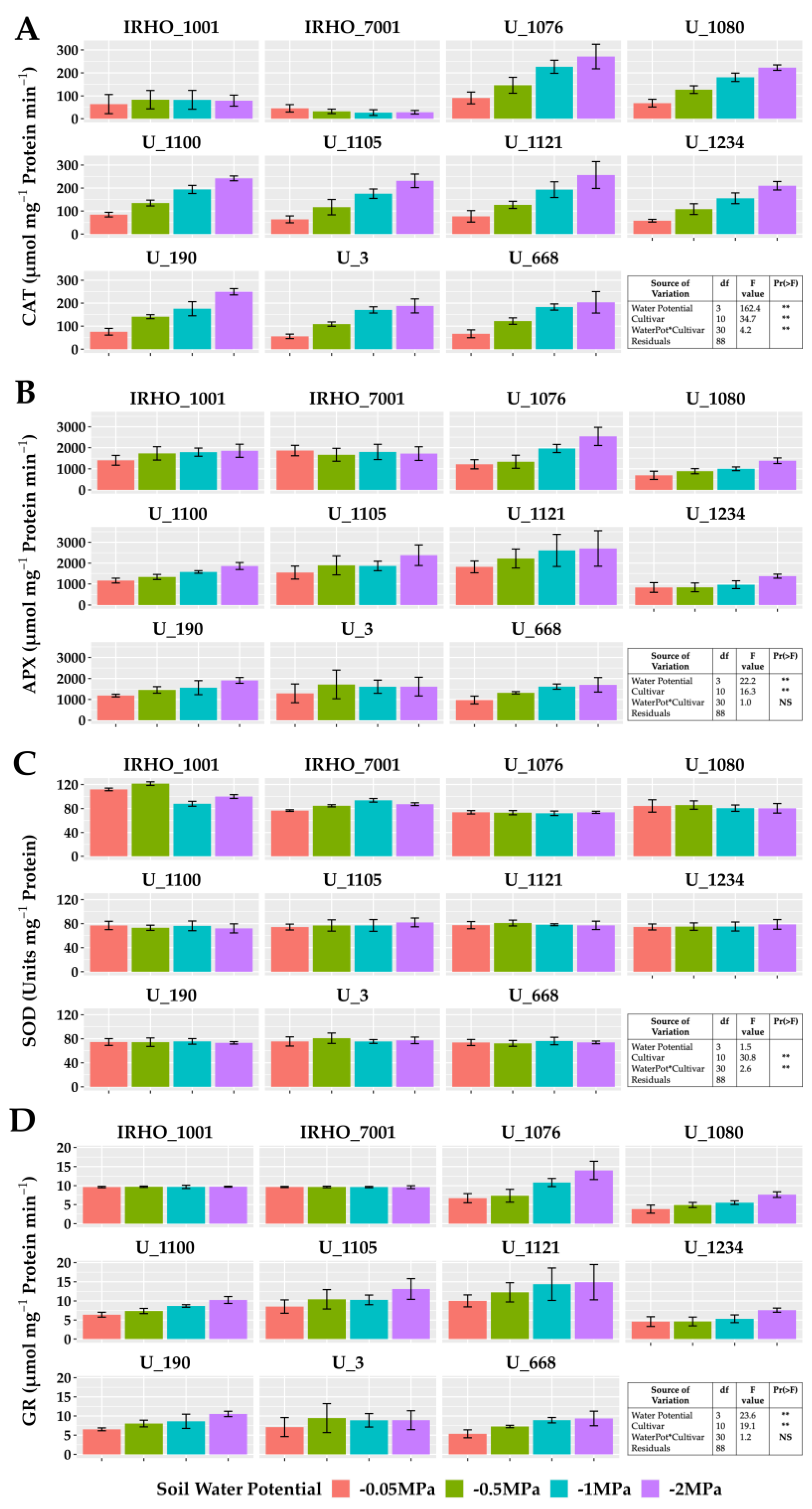

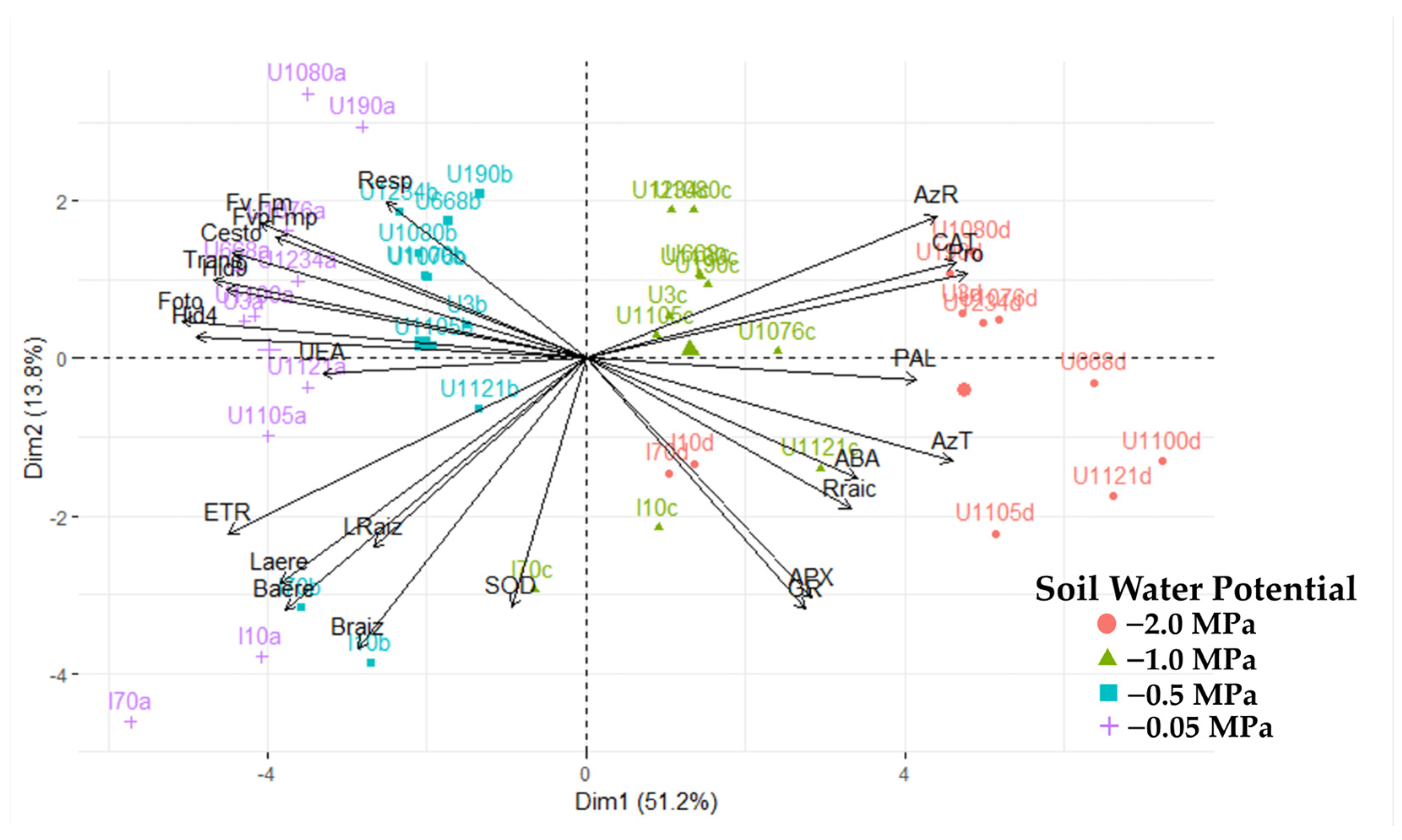
| Cultivar | Mother | Father | Cultivar | Mother | Father |
|---|---|---|---|---|---|
| IRHO 1001 | Deli | La Mé | U 3 | Congo Mixto | Mongana |
| IRHO 7001 | Deli | La Mé | U 1105 | (Ekona × Djongo) | Congo Mixto |
| U 1076 | Djongo | Congo Mixto | U 1121 | Djongo | Congo Mixto |
| U 1080 | Avros | Djongo | U 1234 | (Mongana × Nifor) | Congo Mixto |
| U 1100 | Djongo | Ekona | U 668 | Congo Mixto | Mongana |
| U 190 | Djongo | Mongana |
| Variable | Unit | Variable | Unit |
|---|---|---|---|
| Dry weight root | g | Leaf φ 4 A.M | MPa |
| Dry weight shoot | g | Leaf φ 9 A.M | MPa |
| Root length | cm | Proline | mg g−1 FW |
| Height | cm | Total sugars | mg g−1 FW |
| ETR | -- | Reducing sugars | mg g−1 FW |
| Fv/Fm | -- | ABA | μg g−1 FW |
| Φ | -- | POD | Unit min−1 mg−1 protein |
| A | µmol CO2 m−2 s−1 | APX | nmol min−1 mg−1 protein |
| E | mmol H2O m−2 s−1 | GR | nmol min−1 mg−1 protein |
| DR | µmol CO2 m−2 s−1 | CAT | mmol min−1 mg−1 protein |
| WUE | µmol CO2/mmol H2O | SOD | min−1 mg−1 protein |
Disclaimer/Publisher’s Note: The statements, opinions and data contained in all publications are solely those of the individual author(s) and contributor(s) and not of MDPI and/or the editor(s). MDPI and/or the editor(s) disclaim responsibility for any injury to people or property resulting from any ideas, methods, instructions or products referred to in the content. |
© 2024 by the authors. Licensee MDPI, Basel, Switzerland. This article is an open access article distributed under the terms and conditions of the Creative Commons Attribution (CC BY) license (https://creativecommons.org/licenses/by/4.0/).
Share and Cite
Bayona-Rodríguez, C.; Romero, H.M. Drought Resilience in Oil Palm Cultivars: A Multidimensional Analysis of Diagnostic Variables. Plants 2024, 13, 1598. https://doi.org/10.3390/plants13121598
Bayona-Rodríguez C, Romero HM. Drought Resilience in Oil Palm Cultivars: A Multidimensional Analysis of Diagnostic Variables. Plants. 2024; 13(12):1598. https://doi.org/10.3390/plants13121598
Chicago/Turabian StyleBayona-Rodríguez, Cristihian, and Hernán Mauricio Romero. 2024. "Drought Resilience in Oil Palm Cultivars: A Multidimensional Analysis of Diagnostic Variables" Plants 13, no. 12: 1598. https://doi.org/10.3390/plants13121598
APA StyleBayona-Rodríguez, C., & Romero, H. M. (2024). Drought Resilience in Oil Palm Cultivars: A Multidimensional Analysis of Diagnostic Variables. Plants, 13(12), 1598. https://doi.org/10.3390/plants13121598







